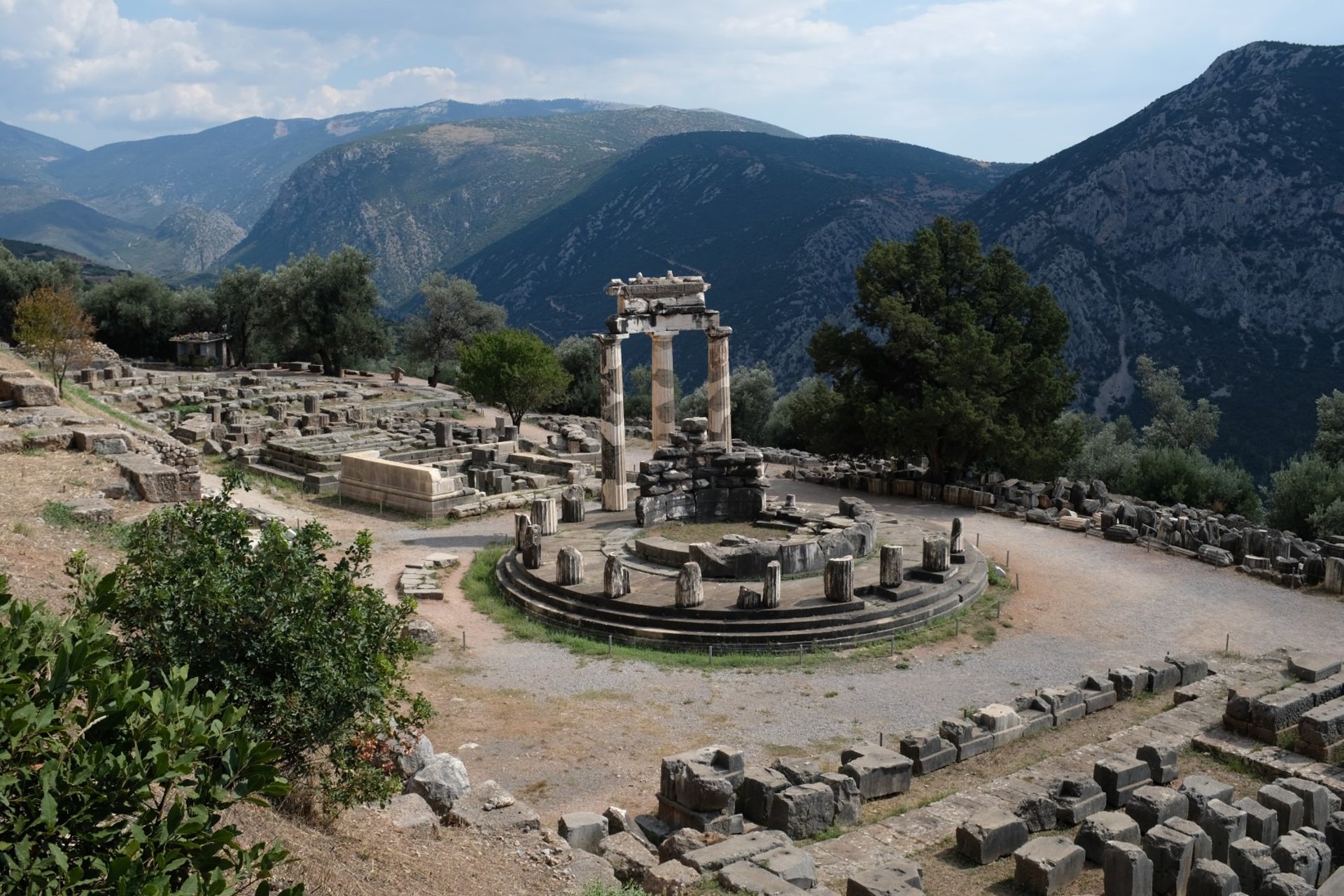
Navel Gazing
2018, Delphi, Central Greece
EUROPEGREECEARCHAEOLOGYMUSEUMS
In Greece they used to say that the centre of the country, and actually of the whole world, was marked by a stone which lay on the slopes of Mount Parnassus. The omphalos was just a stone, but it was also the navel of the Earth, and so at the dawn of history it was watched over by a monstrous snake called the python. One day the god Apollo came to visit the omphalos, the first tourist in a long line. There was some disagreement between himself and the monster, and he killed it. So it goes. The python was that much of a monster though that for aeons after its death you still could smell its rotting carcass.
Stranger yet, if you got a good lungful of it, somehow and for some reason it would tune you in to Apollo's frequency and you could talk with him. The first Greek to discover this was a shepherd. One day he saw his goats become giddy near a fissure in the hillside from where strange fumes emanated, and he went to have a sniff for himself. The ancient sources describe it as an intoxicating vapour, sickly sweet, calling to mind a hydrocarbon gas vent for today's geologists.
The geologists of the day were probably a bit less detached and a bit more poetic. Word spread, people gathered, and as time passed a cult and a profession emerged. It was discovered that the best suited to speak to the god was a woman, the first oracle or sybil. She would sit on a stool above cracks in the earth and breathe in the essence of the slain Earth spirit. She could then transmit questions to Apollo. He would return answers through her, albeit in the form of garbled gibberish. Luckily, there were priests around who could interpret. This sybil was originally called the Pythia and her sanctuary Pytho, after the primordial serpent. Another name caught on later, coming from a root word meaning womb; history remembers the oracle at Delphi.
The Myth
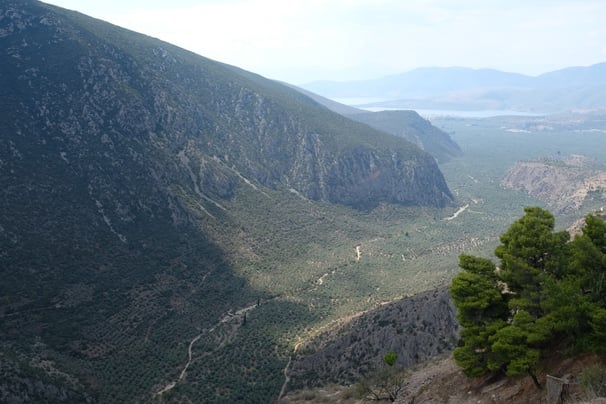

In planning your visit you should also take into account that there are four areas to visit, each at some distance from one another: the main sanctuary of Delphi and its museum, and two smaller ruins about half a mile outside of that. We decided to tick off the two smaller boxes first and went straight to the Sanctuary of Athena Pronoia (Athena of Forethought). The special attraction here, and probably the most photogenic of all the ruins at Delphi is the Tholos, a small circular shrine. I liked its size and shape, which contrast with the huge, stocky rectangles more commonly used in classical architecture. Three out of its original twenty Doric columns have been restored to lend your imagination a hand.
The second smaller site is the Gymnasium, where you can see some hints of a columned portico and the outlines of several athletic buildings. Lord Byron is supposed to have carved his name into a piece of masonry here, among other travellers, but the site was closed during our visit and we could only peer down from the road.
As you enter the main sanctuary of Delphi, what you see today are its much reduced stone remnants standing on a series of hillside terraces. A processional ramp snakes its way up through the site in a slow zig-zag, the same steep pathway once trodden by delegations from across the Greek world. They would each have come carrying offerings to their respective treasury at Delphi, which served as a kind of celestial bank account. Of these the most impressive today is the restored Athenian treasury, but it's also interesting to locate the monuments placed here by other famous cities like Corinth, Argos and Thebes, the island communities like Naxos and Rhodes, and even the farthest-flung Greek colonies like Massalia (modern Marseilles in France).
The Sanctuary
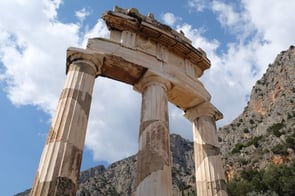
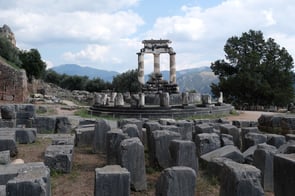


Much later in history I visited the same Delphi with my Dad, the latest pair of tourists in that long line. You can take your pick of tours organised from Athens, but we found it just as easy and a lot cheaper to arrange things ourselves. The bus departs from the long distance bus terminal B, located at 260 Liosion street, a short walk from Kato Patissia metro station. The ticket was €16.40 one way, and the journey took about three hours. It's a good idea to visit the station at least the day before to buy the tickets for the trip out and back, both to be sure of getting a seat and to know your way to the station on the day. Unlike in some other European cities, Athens does not have a centralised travel hub where you can just turn up and roll out.
We arrived at about one o'clock in the afternoon and wasted a lot of time enjoying lunch and drinking retsina before we even looked at any ruins. The weather was mild and clear, and resinated wine seemed like the most refreshing glass of anything we'd ever had. The practice of infusing white wine with tree resin goes back thousands of years to the era before wine barrels, when the sap was used to seal ceramic amphorae. The sharpening effect on the flavour was thus originally an unintended consequence, but a happy one, and this Greek speciality can still be found on menus throughout the country. Just keep an eye on your watch if you open a bottle at Dephi!
The Sanctuary of Athena Pronoia
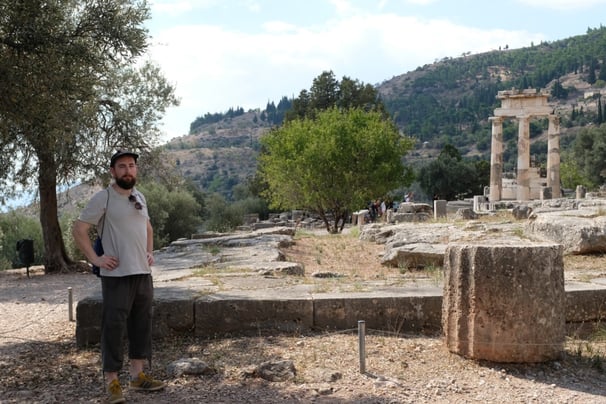

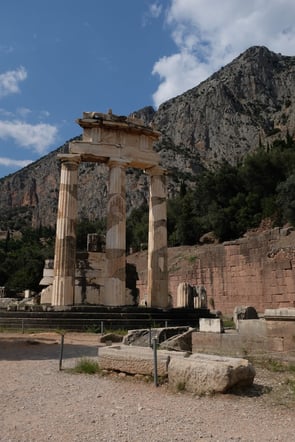
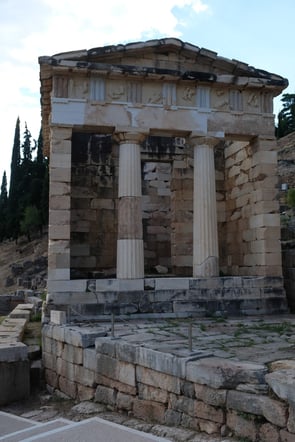


Sanctuary of Athena Pronoia, Athenian Treasury
At some point the sybil moved from the natural crag to a man-made structure further up the hill, the monumental Temple of Apollo. The ruins visible today date back to 330 BC, though that was only the last of several iterations of the shrine. The building was funded by people from across the Greek world, from commoners to kings, and would have been a sight to behold in its day. Tall Doric columns upheld a collar of metopes (relief sculptures), each of which were studded with shields taken from the Persians at the battle of Marathon in 490 BC and from the Gauls during their invasion of Greece in 279 BC. The building was crowned by two marble pediments, on the east face depicting Apollo and on the west face Dionysus, the god of revelry who was said to squat in the temple during the winter. Apollo, god of order and harmony, spent the colder months away in the far north where he was out of coverage. Dionysus for his part was apparently more interested in the present than the future, and no prophecies could be made while he was around.
Carved into the temple were three Delphic maxims: "Know thyself", "Nothing to excess", and "A pledge comes from madness". The first advises us to recognise our own limitations and weaknesses, while the second remains readily understandable for us today. The third seems a bit more cryptic but should probably be read to mean something like "Think twice before making commitments". The common theme seems simple enough: don't get carried away, use your brain. That might say something about the national character of Ancient Greece, which produced such famously combustible personalities as Achilles, Leonidas and Alexander.
The Oracle

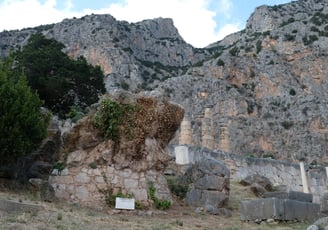
The Rock of the Sybil
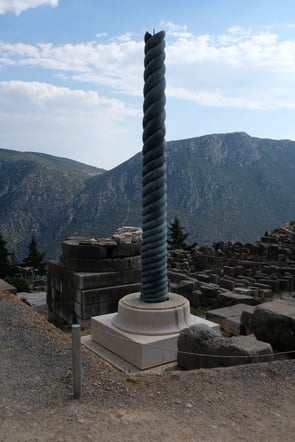
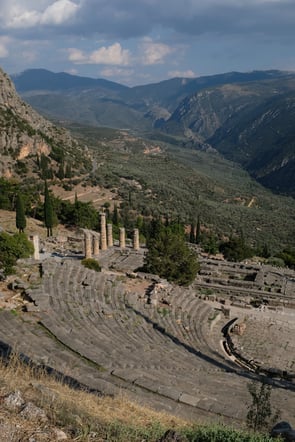


The Serpent Column, Delphi's theatre
Rising like a pulpit among these smooth stone foundations is the jaggedly ancient Rock of the Sybil, the spot from which the original oracle made her exhortations. Enough protrudes from prehistory to hint that the cult here in fact predated its association with Apollo. The masculine Sun deity came here as an intruder, and slaughtered and displaced a snake, a creature associated with the Earth and its personification, grandmother Gaia. Ancient Greece is renowned for its contribution to democracy and to history, but its women could not vote and their thoughts and experiences were rarely written down. Nevertheless, here at the cultural epicentre of the civilisation it was a female voice that everyone came to hear.
More enigmatic was the large letter "E", supposedly once inscribed alongside the maxims, but again, any idea you can summarise with one letter can't have been too complicated.
Near the temple stands a replica of the Serpent Column, one of the most storied artefacts to survive from antiquity. This was a bronze statue of three intertwined snakes, set up at Delphi by the Greeks after their defeat of the Persians at Plataea in 479 BC. While not as famous as the battles at Marathon, Thermopylae or Salamis, where the Greeks were decidedly the underdogs, Plataea was the real turning point in the centuries-long conflict between the two civilisations. Never again would a Persian army land in Europe. The metal for the column was taken from the reforged weapons of the invaders (probably providing the inspiration for George R. R. Martin's Iron Throne), and it bore an inscription with the names of the 31 Greek city states that had stood together on the fateful day. Much later, the Roman emperor Constantine had the column moved to his new capital, Constantinople, as an ornament for its hippodrome (horse-racing track). It was still there in 1453 AD when the Ottoman Turks captured the city, and according to legend, Sultan Mehmed the Conqueror knocked the lower jaw off one of the snake's heads. The column is still there today, in the city now called Istanbul, though it lost its three heads at some point over the centuries. The replica now standing at Delphi might be easy enough to pass over in itself; like so much archaeology, it's real value is in the story it can tell us.
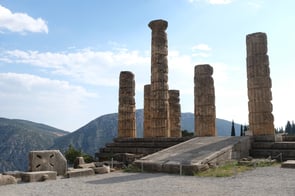
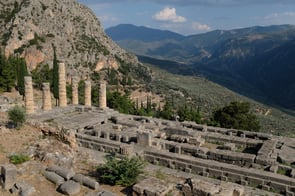


Temple of Apollo
Continuing up the hill from the temple, you're met by the theatre, which with its thirty-five rows could once seat up to five thousand people. The view from above it sweeps down over the rest of the sanctuary and onto the valley of Phocis, the second classic postcard picture after the Tholos. Seeing it with your own eyes gives you an immediate sense of the old culture's closer relationship with nature. The theatre is something we now associate with the upper echelons of civilised city life, but here in the birth place of the art it was an open air event with a view instead of a curtain.
The path ends at the highest terrace, the last flat space cut into the slope before it becomes a sheer cliff. This was the stadium that hosted the Pythian Games, second in importance only to the Olympic Games better known to us today. You can still see the raised stands where the spectators came to watch and the starting line where the ancient athletes crouched immediately before the sprint. I can tell you they would have had a fair warm up just getting to the venue.
The View
Delphi being the place for long walks and big questions, I got into a debate with Dad about whether those runners still existed in some way, since on some distant planet, the light that had left the hillside long ago would now be just arriving. We took our time coming down the hill, towards a consensus that any alien sports fan with a telescope good enough to watch the race would not really be in our now; time being subjective and not objective, you see. On top of that, added Dad, this showed how faster-than-light travel was impossible, since if it were indeed possible, that alien could watch the race finish and then travel to Earth in time to see it start. At least I think that was it. It was as far as we got at any rate before realising that we had again forgotten our own subjective time and would have to run to the museum before it was closed.
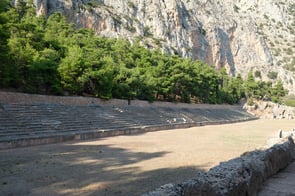
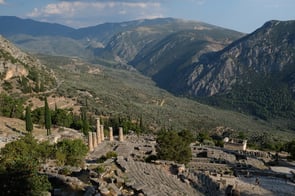


Stadium, View from the top terrace
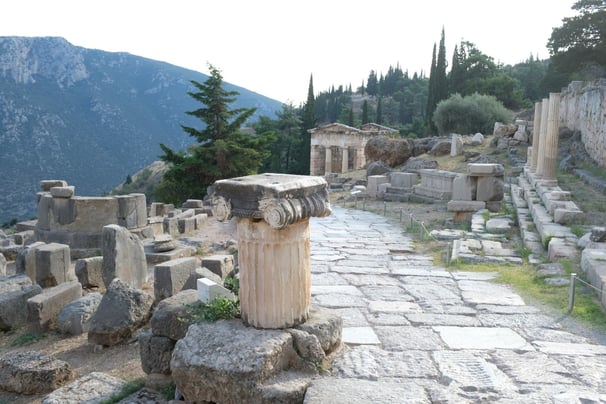

Approaching the Athenian Treasury on the way back down
Delphi's Archaeological Museum is really an essential part of the visit, since it houses most of the delicate treasures found at the site. With fourteen rooms it's also fairly manageable, and the items on display are enough to engross even the most museum-weary visitor. Set aside at the very least an hour - we had to rush through it with three quarters. Apart from the quality of the artefacts, what struck me about them was their strangeness. Classical architecture is not something all that exotic for a Western tourist, since it still informs what we build today. But that's really only the skeleton of classical art, where a lot of the meat has not survived; different materials and colours, intricate detail, subtle ideas and expression.
The chryselephantine statue of Artemis might be the best example. It's a minor miracle that any of this gold and ivory sculpture has survived, still with the mysterious smile imbued by the artist more than two and a half thousand years ago. Even more delicate, the painstakingly reassembled, life-size Silver Bull of Delphi is as much a testament to its restorers as to its original authors. Another stand-out is the bronze charioteer, who cuts a commanding figure even without his horses and chariot, and forces you to ponder the craftsmanship that went into the making. There's more heavy metal on display in the form of the weapons and armour so central to my imagining of the period; a huge circular hoplon shield you can almost feel the weight of through the glass, and Corinthian helms that seem to imply the old eyes that once peered through their face-guards.
The Museum
The main material on display is still stone, but hewn into many forms. For me the Sphinx of Naxos and the twin giants Kleobis and Biton wouldn't look out of place in Egypt or Iran; a reminder that this civilisation belonged much more to the eastern Mediterranean than to Europe. In adjoining rooms you can also find sculpture in the more familiar realistic style, with the statue of the Philosopher, and especially of Agias of Pharsala every bit as precise as you'd expect from something made today. Here too, protected now by a glass case and a museum attendant instead of a giant snake, is a carved marble egg, the Omphalos of legend.
For anyone with an interest in the history, Delphi will be a real marvel and probably an essential bucket-list visit. For the more casual visitor it could make a great introduction to the ancient world, connected as it is with so many dramatic events and colourful characters. Do consider hiring a guide or doing some reading ahead of time to get the most out of your visit, and of course, have a think about what you're going to ask the sybil.
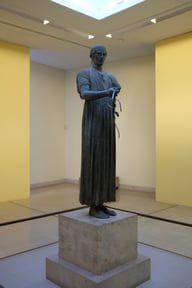
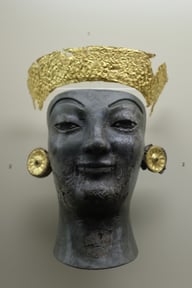
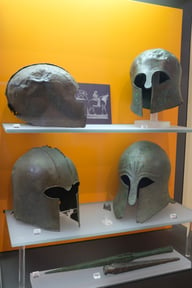



The Charioteer, Artemis, Corinthian helmets
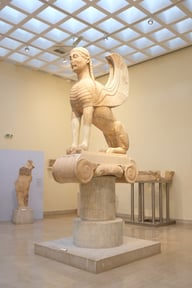
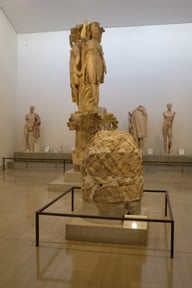
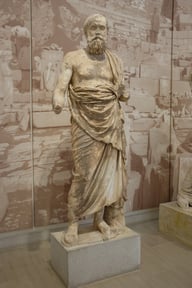



The Sphinx of Naxos, The Omphalos (in foreground), The Philosopher
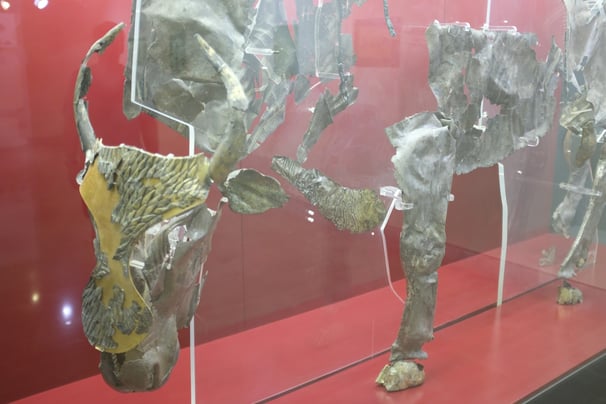

The Silver Bull
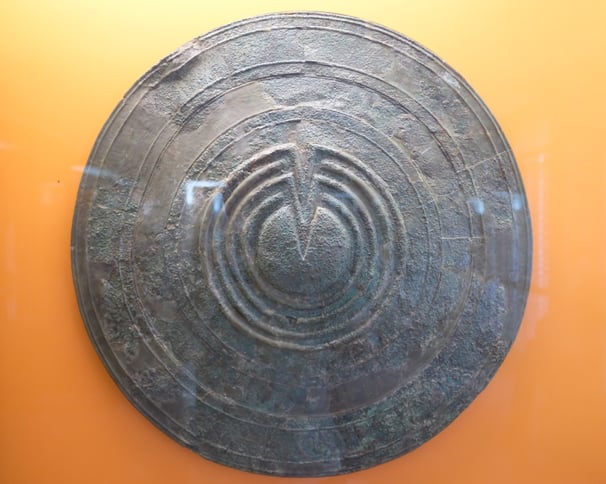

Hoplon shield
The Gist: Delphi
ARRIVED: We got to Delphi by public bus. It departs from the long distance bus terminal B, located at 260 Liosion street, a short walk from Kato Patissia metro station. There was no return ticket, so we got two tickets each to get to Delphi and back, meaning €16.40 x 2 = €32.80 per person. We bought our tickets the day before travel.
SLEPT: We stayed with an airbnb host in Athens. It is possible, though obviously more expensive to stay in town at Delphi.
DID: Delphi is a large site and will take a full day to visit properly. The highlights for me were the Sanctuary of Athena Pronoia, the treasuries of the different Greek city states, especially the Athenian Treasury, the Rock of the Sybil and the Temple of Apollo, the Serpent Column, the theatre, the stunning views from the top terrace, and Delphi's own Archaeological Museum which houses the more delicate artefacts from the site.
LEFT: We came back on the same public bus, having booked the tickets for both journeys the day before.

